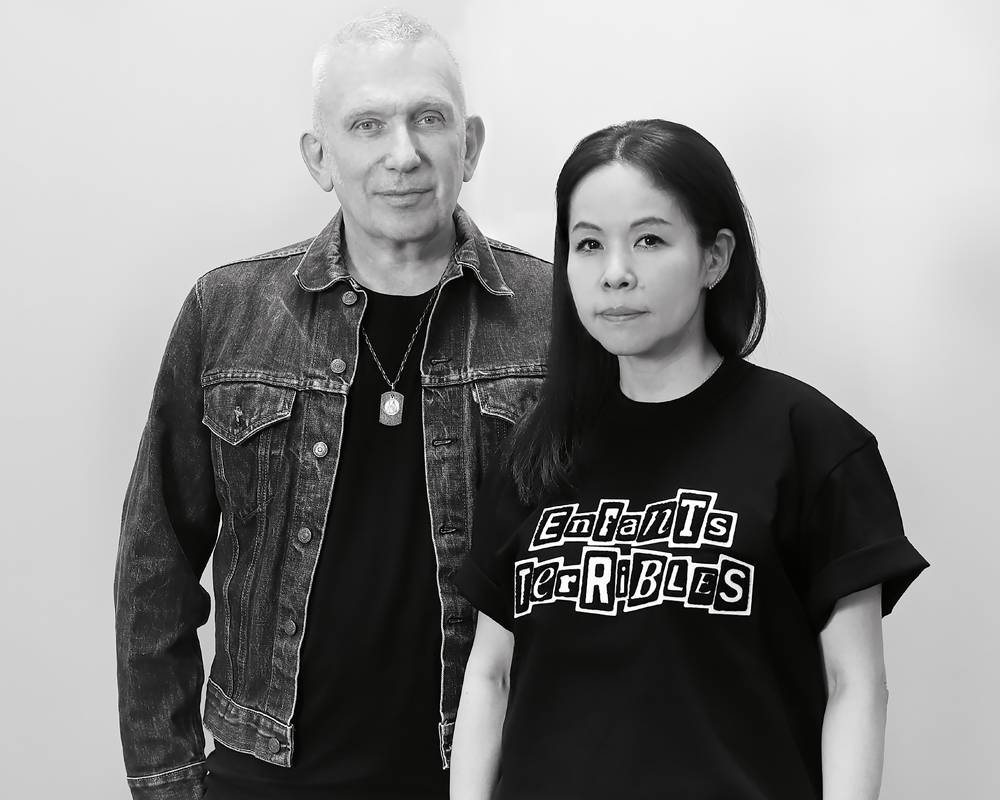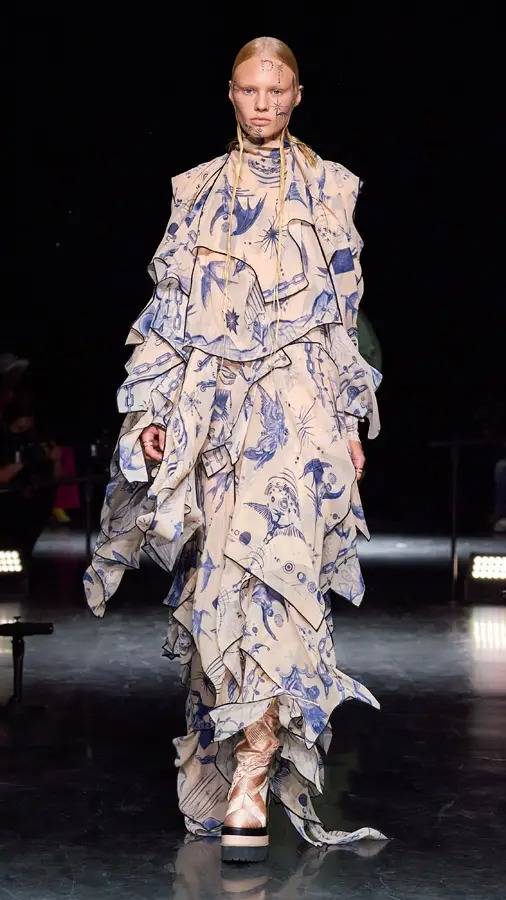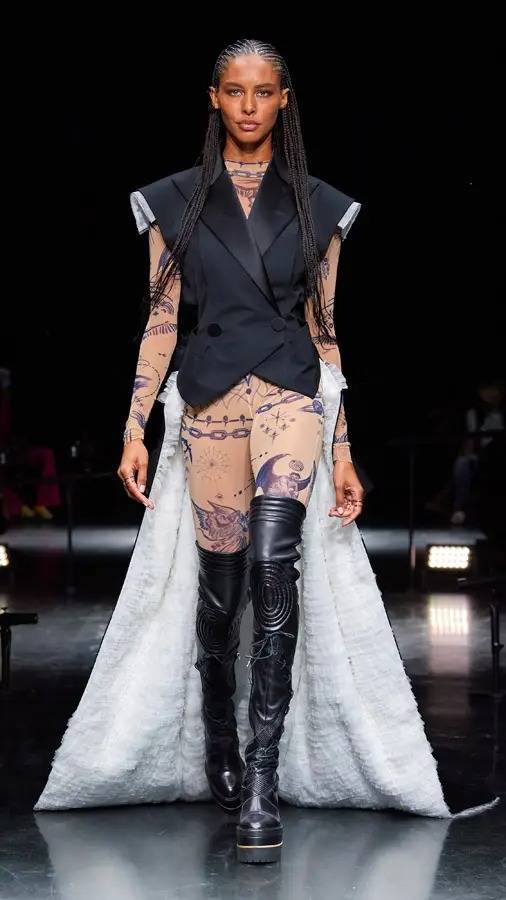
24
Jean Paul Gaultier and Chitose Abe talk about their exceptional collaboration
In January 2020, Jean-Paul Gaultier presented his last haute couture show. A masterful, impertinent and generous proposal by some two hundred models reinterpreting her own archives and bringing together her heroines, Rossy de Palma, Catherine Ringer and Farida Khelfa, alongside Bella Hadid. The couturier has decided to invite a designer each season to revisit the DNA of his house. The first to be invited, Chitose Abe, from the Sacai label, reinterpreted the archives of Gaultier Paris by applying her learned art of deconstruction and hybridization.
Published on September 24, 2021. Updated on May 31, 2024.

NUMBER: Jean-Paul, you presented your last couture show last year, why did you feel that the time had come to bow out?
Jean-Paul Gaultier: It was a necessity to do this last parade. I started at Cardin at the age of 18, I launched my own collections in 1976, and I haven’t stopped… Between Hermès and my house, I worked a lot. My shows have been theatrical, but recently, I wanted to come back to the show itself: the Folies-Bergère shows that I saw when I was 9 years old were a detonator in my life. So I wanted to imagine a review. It was the first symptom that indicated that I was going to quit fashion. The pace was frenetic, more and more collections, more and more brands… the world has changed so much since that day in April 1970 when I joined Cardin: it was fifty years ago!
You then announced that Chitose Abe and his brand Sacai would present a haute couture collection on your behalf. Why this choice?
J.-P. G.: Ithought it would be interesting to suggest to a designer to live in the Jean Paul Gaultier house for a while, and to do what he wanted with it. I had already spotted Chitose for a while. I have always loved Japanese fashion. Rei Kawakubo and Yohji Yamamoto had a very new vision, very different from our Western vision. I had seen that Chitose had proposed a sailor shirt with a back all in guipure, and she had also reworked the trench coat in the same spirit as me: you modify the classic, you slash it, you shake it up… His deconstruction of clothing meets my idea of recycling, as during the Second World War when women sometimes took their husbands’ trousers and transformed them into skirts. I also saw her clothes in her shop in Tokyo, and I was impressed by the quality of the materials, the fur and the leather… So I didn’t hesitate, it was her and no one else. I am very happy to be able to do this project with such a talented person.

Chitose, do you feel close to the spirit of Jean-Paul? Has he inspired you a lot?
Chitose Abe: I’ve admired Jean-Paul Gaultier’s work since I was in my twenties. I also bought some of his pieces. When I met him, he told me that he had gone to see my clothes in my shop in Tokyo. It’s really exhilarating to hear that from someone you admire. I was very moved that he was able to understand so well what Sacai is. For me, it was therefore an honor that he offered me this collaboration, I immediately accepted.
He never stopped rethinking the classics to radically transform them and make them correspond to new heroines. Do you feel close to him, in the way you hybridize clothes, create unclassifiable pieces?
C.A .: Yes, we are very similar in the way we rework classics such as trench coats, sailor shirts and denim. On this basis, we know how to create absolutely new pieces using our technique, our know-how. I think what brings us together is the idea of thinking outside the box, to always try to come up with something strong and unexpected.
However, your approaches are quite different in your relationship with the body.
J.-P. G.: Yes, because Japanese eroticism is very subtle: it’s the collar that shows the nape of the neck, for example. My eroticism is more inherited from the 50s, it’s sexier: with corsets, bustiers, it’s about showing and sublimating the body.
C. A.: At Sacai, we present specific men’s and women’s collections, but also unisex pieces. And in general, I mix and rework the masculine and feminine codes on my silhouettes, so this reflection on gender is an integral part of my approach.
How did your meetings go? Jean-Paul, did you give Chitose total freedom to draw on your archives?
J.-P. G.: Chitose wanted to present a physical show, not a digital one, and she was right. Of course, because of the health situation, it has been postponed several times. We met on several occasions, in Paris and in Japan. I presented it to people in my company, to the workshops, to the studio… And yes, I gave him total freedom. Obviously, I saw the sketches go by, I was very happy to see how she took up the Gaultier codes in her own way, with her femininity and creativity. It’s her, but it’s Gaultier Paris.
C. A.: I think we met three times before presenting this collection. I was eager to be able to work, because of course, creating the collection via zoom, remotely, was impossible. I needed to communicate with the workshop, to be able to touch the fabrics. And I think, in general, that it’s important to present physical shows: the public needs to feel and see the emotion that a collection gives off.

Were you happy to discover the workshops of the house?
C. A.: The workshops are incredible. We communicated in detail, to understand our respective codes and find the best way to create the Gaultier Paris by Sacai collection. Throughout this process, Jean-Paul was wonderful, he kept telling me that I had to believe in myself.
Jean-Paul, how did you experience this first haute couture show of your house directed by another designer?
J.-P. G.: I was very happy because Chitose did a very good job, she respected the identity of Gaultier Paris very well, which she mixed with her Japanese culture. The volumes she has imagined are truly singular. For example, I’ve never made very high-waisted pants with so much volume, which almost become skirts. She took techniques that I had already used, making them evolve. I was very moved to see the result, and I also liked the models, the presentation… It was me without being me [rires].
Where did you come up with the idea of inviting five young designers to interpret your ready-to-wear [Nix Lecourt Mansion, Alan Crocetti, Palomo Spain, Marvin M’Toumo and Ottolinger]?
J.-P. G.: It didn’t come from me, but from the people who take care of the house [sous la houlette de Florence Tétier]today. Since I had announced that my fashion house would be inhabited by a new designer each season, they had the idea of extending my gesture with this proposal. But let me make it clear, this is not a return to seasonal ready-to-wear collections. They will only be capsules. In any case, to see clothes and fashion shows that are both my own and someone else’s, it’s a joy.














